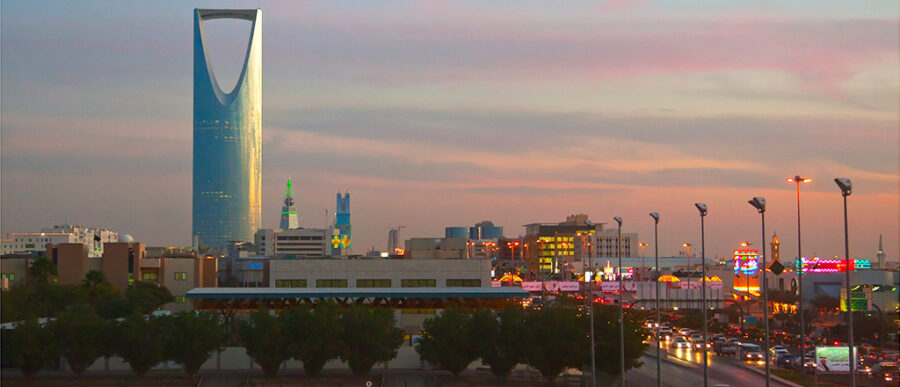In the face of plummeting oil prices, Saudi Arabia, the world’s largest oil producer, has announced an economic strategy to shake off Saudi overreliance on fossil fuels. Dubbed “Saudi Vision 2030,” Deputy Crown Prince Mohammed bin Salman, second in line to the throne, has proposed changes to wean the Middle Eastern country to be less dependent on oil and generate $100 billion in additional non-oil revenue by 2020, according to Bloomberg.
The drop in oil prices started a new era, observers say, and like other oil-dependent economies, Saudi Arabia needs to diversify. But moving from an oil state to a viable, industrialized economy is a challenging task, says Wharton finance professor Bulent Gultekin.
“[The government] has to be smart enough and creative enough to make that transition,” he says. “And they have to do it sooner rather than later” as oil prices are not expected to climb back up to mid-2014 heyday prices of $100 a barrel.
As a result of the sliding prices, the government had a $98 billion budget shortfall and its deficit ran around 16% of GDP in 2015. About 90% of the government budget and almost all its exports rely on the petroleum sector, Bloomberg reported.
Kicking the Habit
“We have developed an oil addiction in Saudi Arabia,” Prince Mohammed told the al-Arabiya television news channel. His bold proposal calls for changing that course, greatly reducing government dependence on oil by 2020. In order to do that, the 30-year-old monarch plans to restructure Saudi Aramco, the state oil company.
“What they need to be careful of is the challenge between weighing the government versus private capital markets.” –Erik Gilje
“Theoretically [the plan] makes sense … to monetize their oil assets. What they need to be careful of is the challenge between weighing the government versus private capital markets,” says Wharton finance professor Erik Gilje. “A perfect example of this is state equities have created very large problems. If the government starts picking winners and losers, you start having a lot of leakage unless you have proper institutions in place and rule of law. Certainly this shows a lot of promise. One could argue that the Prince should have been doing it a while ago.”
Aramco is the world’s biggest oil producer with the capacity to produce twice as much oil than any other company. In an Economist interview, Prince Mohammed said they have the third-largest oil reserve in the world, which is easy to access and cheap.
Less than 5% of Aramco’s stake would undergo an initial public offering, with an expected value of $2 trillion. The IPO would be on the domestic stock market, but listing on another market would make sense, says Gilje. “Presumably there are not enough foreign investors or Saudi investors to purchase all the shares they want to issue. They’re going to have to list somewhere else to have any chance of getting the equity and quantify of investors they want to achieve their goals.” Plans also call for the oil behemoth to be transformed into an “industrial conglomerate.”
The ownership of the rest to the company would be transferred to Saudi’s sovereign wealth fund, known as the Public Investment Fund (PIF). Prince Mohammed believes this would raise the value of the fund, potentially making it the world’s largest sovereign wealth fund in the world.
In a segment on the Knowledge at Wharton radio show on SiriusXM, Karen Young, senior resident scholar at the Arab Gulf States Institute in Washington, D.C., points out this move still centers the economy on oil rather than truly diversifying the economy by creating jobs and implementing restructuring reforms. “The distribution of wealth from this asset will still be closely guarded in the hands of the state, which is the [Royal] family,” she adds. “It calls into question corporate governance, about domestic government and what the relationship is between state and economy in Saudi Arabia.”
In addition, foreign investment on the Saudi market is restricted though Prince Mohammed is loosening regulations, according to Bloomberg. Financial measures for Saudi Aramco’s performance are also not public so it may deter some investors. However, in order go through the process of doing an IPO, Gilje points out that Aramco will have to go through audits, external accounting and so forth, just like other public companies.
Gultekin points out that Saudi Arabia is a more secure place to invest than many people may realize. Foreign investment will be fine despite the concerns about the legal system and the questions about the regime, he says. “Democratic places are not always, unfortunately, the best places to invest — like the southern perimeter of eurozone,” says Gultekin.
Prince Mohammed also called for the private sector to grow to 60% from the current 40%. Government services like education, health care and airports will be transferred to the private sector. As the country adjusts to the transition, economic growth is expected to slow as private sector expands.
Fuel, electricity and water subsidies have already been cut — a move in the right direction, some observers say. “Oil-producing nations should quickly phase out fossil fuel subsidies. They are a drain on the government budget, they take away any incentives for energy conservation and green innovation, and subsidizing energy is exactly the opposite of what countries should be doing to improve the environment,” says Arthur van Benthem, a Wharton business economics and public policy professor. “I think any serious attempt to reform the economy entails getting rid of those subsidies, and investing the extra revenues in technologies that are well suited to the Saudi Arabian economy.”
In Bloomberg, Mohammed Al-Sheikh, Prince Mohammed’s financial advisor, said that $80 billion to $100 billion annually was wasted on inefficient spending up until last year. The country was headed on a path of becoming insolvent by 2017. As Gultekin points out, “They have no choice but to pay more attention to government expenditures.… Oil income is not as abundant as it used to be.”
“Democratic places are not always, unfortunately, the best places to invest — like the southern perimeter of Eurozone.” –Bulent Gultekin
Another big expenditure for Saudi Arabia is its military spending. The country is one of the biggest buyers of weapons in the world. Saudi Arabia is the main military backer in Yemen, where a proxy war with Iran is taking place. “Saudi Arabia believes there is an Iranian threat” and they would like to develop into a militarily powerful country in the region, says Gultekin.
Labor Force Conundrums
Moreover, the Kingdom has very high unemployment, noted William Megginson, finance professor at both the University of Oklahoma’s Michael E. Price College of Business and King Fahd University of Petroleum and Minerals in Saudi Arabia, during the segment on the Knowledge at Wharton SiriusXM show. Currently, the official figure is around 11% but Young points out that it is likely higher as many people have simply stopped looking for a job. Youth unemployment is already nearly 30%, according to the World Bank.
Gultekin points out that Saudi Arabia has one of the youngest populations in the world. Two-thirds of Saudis are under 30 years old. It’s a challenge to develop job prospects for this booming population, adds Gilje. “Their situation might be more similar to Western countries after World War II. They might have a lot of opportunities if protections can be put in place, such as to protect capital so that firms will be able to grow and foster competition. With a growing private sector, they need to make sure all the lucrative jobs are not just going to members of the Royal Family or [other types of] cronyism,” says Gilje
Young points out that women have an especially hard time finding jobs. “The barriers for women are immense,” she says. “Many Saudi women are university educated but can’t find a job after university,” adds Megginson.
In addressing the gender issue in a country where women are still not allowed to drive, Prince Mohammed envisions women playing a more dominant role in the future and he called for women’s participation in the labor force to rise to 30% from 22%.
Developing the manufacturing sector is important to absorbing the young population, says Gultekin. “Despite the wealth and the high GDP per capita in the country, it’s not an industrialized economy,” says Gultekin. Saudi Arabia doesn’t have exports other than oil, and if it had a strong industrial base, the country would have the chance to rely on other industries to make up the loss from falling oil prices. “You never see products that say ‘Made in Saudi Arabia,’” Gultekin points out.
“They need to build a diversified and competitive economy. That’s a very challenging task. All the emerging countries are also striving to be competitive and technology-driven economies.… Saudi Arabia has been aware of this and, for example, they have been trying to build chemical industries using its oil base. Such efforts need to speed up. That’s not an easy thing to build competitive industries quickly,” notes Gultekin.
Another paradoxical feature of the labor force in Saudi Arabia is the high proportion of foreign workers, even with a sizable unemployment figure. “Most of the [menial] work has been done with imported labor,” says Gultekin. Only 20% of the labor force in the private sector is Saudi while 67% of government employees are Saudi, according to Bloomberg. “The oil wealth has created a complacency within the population.… Building human capital and changing habits and, sometimes norms, of the population is a real challenge,” adds Gultekin.
“I don’t think there have been any oil economies that have successfully altered their economic structure.” –Howard Pack
Even as oil pressures remain, Saudi Arabia has said it won’t freeze output as long as Iran keeps pumping oil. It was only in January that sanctions against Iran were lifted. “The ending of sanctions against Iran will bring additional oil to the world market. Iran wasn’t completely cut off but they were quite restricted,” Gultekin says. “They needed technology from the West to improve the efficiency of oil production. With [improved] technology and the U.S. getting better with shale oil, all of a sudden there’s not a scarcity but an abundance of oil. All of these factors indicate that oil prices are not going to be climbing up drastically pretty soon.”
What Other Resource-rich Countries Do
When you look at other countries with rich natural resources, many have not been able to successfully diversify their economies.
Another oil-rich country is Norway. “They knew their oil fields would be depleted one day,” Gultekin points out. With that in mind, Norway has been building a massive sovereign wealth fund to “maintain a standard of living in the future generations. You put the money to the side now and that’s the idea,” says Gultekin.
The Scandinavian country also has a high income tax with a small population, while Saudi Arabia doesn’t have any income tax and a rapidly growing population. Norway’s fund could potentially be dwarfed by Saudi’s planned Public Investment Fund, which could be four times the size and the largest in the world.
“The immediate challenge isn’t to build the largest sovereign wealth fund. It’s sizable already,” says Gultekin. Saudi Arabia has to get a hold of its investment expenditures and, if not, then raise taxes, and most importantly, rationalize their spending priorities, says Gultekin. Gilje adds: “The Norwegian sovereign wealth fund has been one of the most transparent ones in the world.… There’s a cost of not being transparent given the goals [Saudi Arabia has] outlined. That ensures the sovereign wealth fund won’t get siphoned off.”
Howard Pack, Wharton emeritus professor of business economics and public policy, adds, “I don’t think there have been any oil economies that have successfully altered their economic structure.” Many have tried, but exchange rates tend to hamper such transitions by making “imports into the country too cheap for local economies to compete.”
Looking at diamonds rather than oil as a valuable natural resource, Botswana is an interesting example. “Botswana has overcome the problem to some extent but at the cost of considerable economic inequality,” adds Pack. According to the World Bank, Botswana is one of the fastest growing economies in the world, having reduced poverty levels from 50% in 1966 to 19% today. The country has managed its diamond wealth without going on a spending spree and adhered to a national budget plan, Pack notes.
Saudi Arabia may be moving in the right direction with an aim to lessen the country’s dependence on oil. “Because of the complacency created by the oil wealth, it is quite difficult to change habits and push the population to work harder and to be more innovative. And even with all those oil resources, it still remains to be seen if things can change,” says Gultekin.



